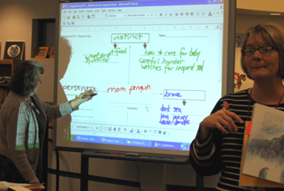 To continue with discussion of the Educational Leadership “Professional Learning: Reimagined” issue…
To continue with discussion of the Educational Leadership “Professional Learning: Reimagined” issue…
In their article, Emily Dolci Grimm, Trent Kaufman, and Dave Doty share their experience of “flipped peer observation.” This strategy is teacher-driven, classroom-embedded, and puts the educator who is being observed in the driver’s seat “as the leader and primary learner in the observation process” (25). After the educator identifies the target curricular standard to be observed, she invites colleagues to a meeting to share her focusing question and provide lesson background. During the observation, the observers collect data related to the targeted standard, and in a post-observation debriefing the educator and observer team discuss the outcomes in terms of the teacher’s focus. In their article, Grimm, Kaufman, and Doty provide guidelines for these three components and share the positive results of this process for one particular teacher.
Privileging the teacher’s voice and her own priorities for professional learning are the foundations for the success for this strategy. The multiple perspectives on instruction and students’ practice are strengths of the process they describe. But I wonder how many school districts will support a process in which a team of teachers must leave their own classrooms in order to provide this kind of professional development for their colleagues. This may work in schools with shared planning time during contract hours, but this level of commitment is beyond what I have experienced in the districts where I have worked or observed.
State-certified school librarians who serve in schools with flexible schedules and paraprofessional support have the opportunity to coteach with peers whenever the need arises. A classroom teacher or specialist and the school librarian can coplan (during the classroom teacher’s planning time) and schedule time for coteaching in the classroom, library, lab, on athletic field, or whatever environment is most conducive to students’ meeting the learning objectives. Along with their colleagues, they can achieve the goal of job-embedded professional development that improves the practices of both classroom teachers and school librarians and the learning outcomes for students. Win-win-win.
Last week on this blog, Judy Kaplan pointed readers to a crowdsourced video: Principals Know: School Librarians Are the Heart of the School.
Dr. David Loertscher who teaches school librarianship at San Jose State University asked his graduate students to conduct a content analysis of the video in search of keywords and concepts that were most often repeated by the ten school administrators from seven different schools in six different states. Their findings: “professional development” was the activity most often ascribed to effective school librarians and valued by these administrators.
To quote Principal Paula Godfrey, Gale Elementary School, Tucson, Arizona, “Professional development happens as teacher librarians and classroom teachers collaborate together on projects for their students.”
To me that is professional learning reimagined. That is truly job-embedded professional development—in which educators work toward shared goals and learning outcomes for students and learn with and from one another in real time with real students, actual curriculum, resources, supports, and constraints of their actual teaching environment. This is an opportunity on which classroom teachers, specialists, librarians, principals, and administrators should capitalize in order to help all educators reach their capacity and all students to reach their potential!
Works Cited
Debra (Librarian) and Melody (3rd-grade Teacher) Coteaching Photo from the Personal Collection of Judi Moreillon – Used with Permission
Godfrey, Paula. “Principals Know: School Librarians Are the Heart of the School.” April 2014. Web. Youtube.com. 8 May 2014. <http://youtu.be/bihGT7LoBP0>.
Grimm, Emily Dolci, Trent Kaufman, and Dave Doty. “Rethinking Classroom Observation.” Educational Leadership 71.8 (2014): 24-29. Print.
